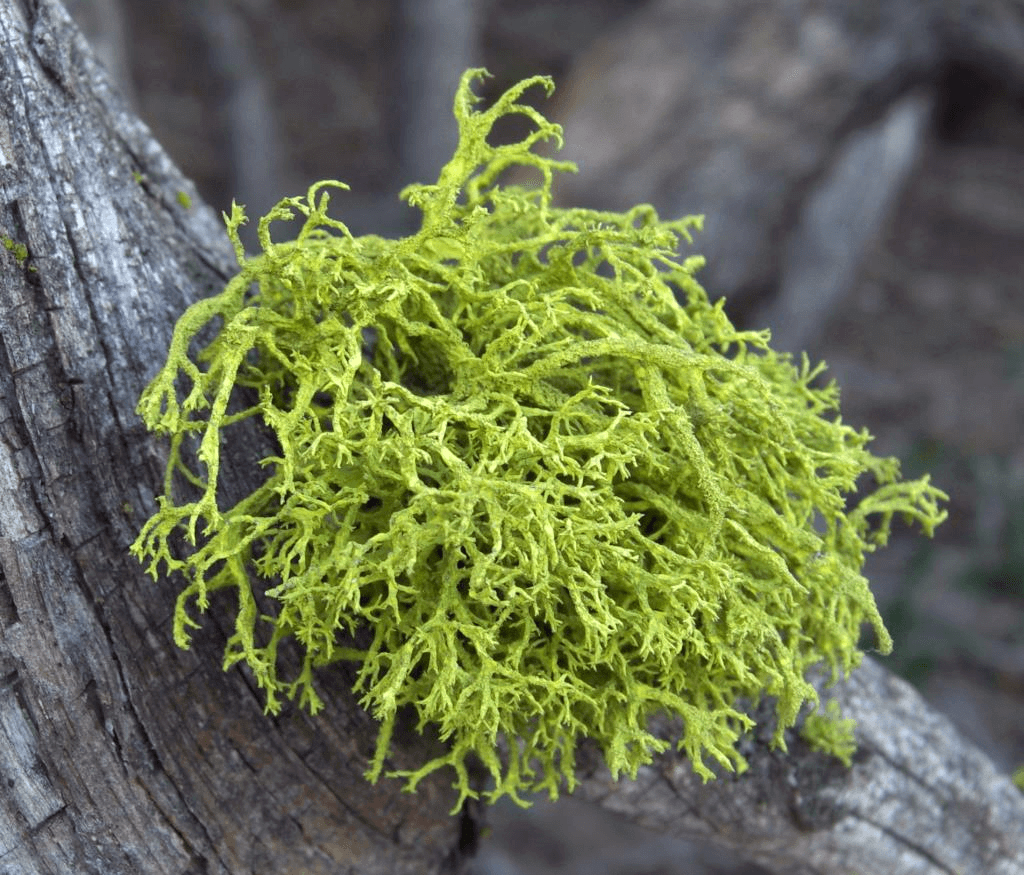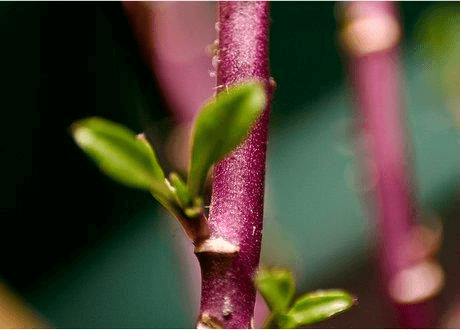Bacteria, Virus, Algae, Fungi & Lichens | Science & Technology for UPSC CSE PDF Download
| Table of contents |

|
| What is Bacteria? |

|
| Virus |

|
| Thallophyte |

|
| Lichens |

|
| Root |

|
| Stem |

|
| Plant Groups |

|
What is Bacteria?
Bacteria are microscopic, single-celled entities that flourish in diverse environments. Some thrive in the soil; others live deep inside a human gut. Some bacteria are useful to humans, while others are malevolent and cause disease. The bacteria that cause diseases are known as pathogens.
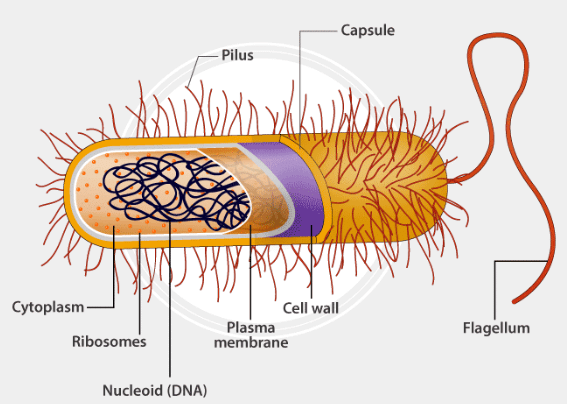 A bacteriaBacteria are prokaryotes, which means that membrane-bound organelles are absent. Consequently, the nucleus is also absent in bacteria. Instead, a thread-like mass known as the nucleoid contains the cell’s genetic material.
A bacteriaBacteria are prokaryotes, which means that membrane-bound organelles are absent. Consequently, the nucleus is also absent in bacteria. Instead, a thread-like mass known as the nucleoid contains the cell’s genetic material.
Characteristics Of Bacteria:
- Bacteria are single-celled entities. Most eubacteria and archaeans grow as independent single cells while some bacteria (myxobacteria) living in the soil form multicellular fruiting bodies that are part of their life cycle.
- Bacteria do not possess complex organelles inside the cells. However, they do possess an internal organization since the DNA is segregated into sites known as a nucleoid, but these nucleoids are not actually divided from the remaining cell through a membrane.Question for Bacteria, Virus, Algae, Fungi & LichensTry yourself:What is a characteristic of bacteria?View Solution
- The plasma membrane is not a feature of bacteria, as seen in other living cells. Specialized folding of the plasma membrane enables the photosynthetic bacteria to carry out light-dependant reactions of photosynthesis which the photosynthetic eukaryotes carry out on the thylakoid membranes inside the chloroplast.
- The bacterial cell contains ribosomes that are spherical units in which proteins assemble from amino acids with the use of data that is encoded in the ribosomal DNA.
- Bacteria have a profound impact on the world’s ecology and play a major role in modern medicine and agriculture.
Virus
Viruses are the smallest acellular organisms, obligately parasites, possess characters of both living and nonliving and so are called the connecting link between the living and the non-living.
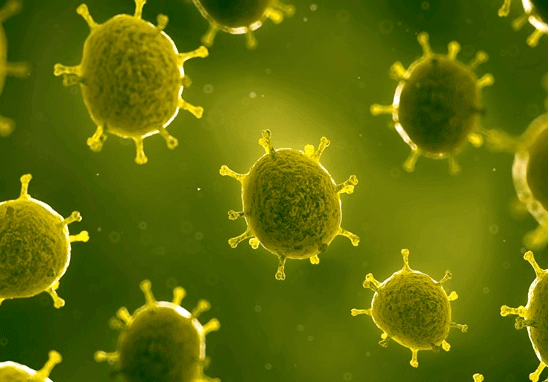 Generic virus illustrations
Generic virus illustrations
➤ Its non-living characteristics are
- No cellular organization.
- Can be obtained in the form of crystals.
- No metabolism of its own.
- No existence outside the body of the host.
➤ Its living characteristics are
- Can replicate within the host.
- Contains genetic materials, e.g., DNA or RNA.
- Can undergo mutations.
- Chemically viruses are made up of protein coat and one of the genetic materials (DNA or RNA). Hence, these are defined as nucleoprotein particles.
Difference Between Virus and Bacteria
One significant difference between viruses and bacteria is their size. Generally, bacteria are much larger compared to viruses. Other significant differences are as follows: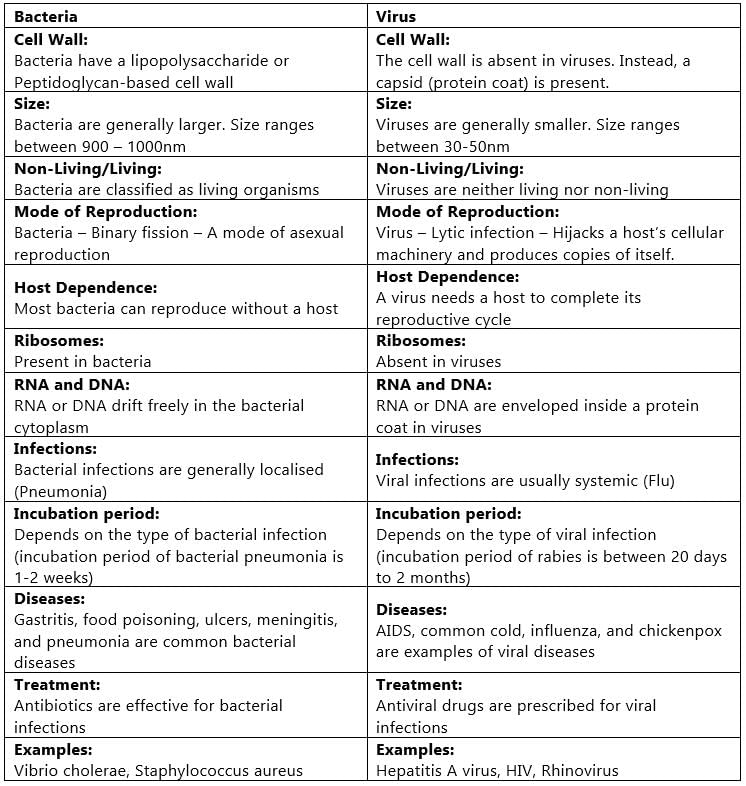
Frequently Asked Questions
Q.1. Why are viruses not affected by antibiotics?
Ans. The property of antibiotics is to target certain proteins, or cellular structures present exclusively in the bacteria.
For instance, antibiotics usually target a bacteria’s cell wall, metabolic pathways, DNA gyrase, ribosomes, or topoisomerase. But since these proteins or structures are absent in viruses, antibiotics are useless. In other words, antibiotics operate on the basis of selective toxicity.
Q.2. Why are viruses known as obligate parasites?
Ans. Virus particles are inert outside cells. Therefore, they need to highjack the cellular machinery of their hosts for vital functions.
Q.3. List five diseases caused by viruses.
Ans. Smallpox, Ebola, Hepatitis, Herpes, AIDS
Q.4. Write any five applications of bacteria.
Ans. The applications of bacteria are as follows:
1. Bacteria is extensively used in the fermentation process, such as baking and brewing.
2. The Lactobacillus bacteria are known to form curd from milk.
3. Bacteria are used in the chemical manufacturing of ethanol, organic acids, enzymes, etc
4. They are used in the production of pharmaceuticals.
5. Most importantly, certain bacteria such as Rhizobium are useful for atmospheric nitrogen fixation.
Q.5. Which bacteria are resistant to antibiotics?
Ans. Usually, bacteria do not resist antibiotics, but some bacteria such as the golden staph or the Staphylococcus and the Neisseria gonorrhoeae have developed a resistance to the antibiotic, benzylpenicillin.
Thallophyte
Thallophytes are a polyphyletic group of non-mobile organisms that are grouped together on the basis of similarity of characteristics but do not share a common ancestor. They were formerly categorized as a sub-kingdom of kingdom Plantae. These include lichens, algae, fungus, bacteria, slime molds, and bryophytes.
Characteristics of Thallophyta
- They are usually found in moist or wet places.
- This is due to the absence of “true roots” and vascular tissue that is needed to transport water and minerals. Hence they are found in moist or wet places.
- They are autotrophic in nature.
- Most members of this group manufacture their own food. But a few members like fungi are dependent on other sources of food.
- Reserve food is generally starch.
- After photosynthesis, glucose is produced and consumed almost immediately, the remaining glucose is converted into complex compounds called starch.
- They have a cell wall composed of cellulose around their cells.
- Absence of vascular tissue.
- Unlike other plants, xylem and phloem are absent. etc
- Sex organs are simple, single-celled, there is no embryo formation after fertilization.
Division of Thallophyta
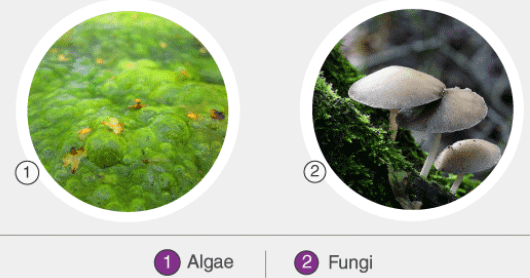 ➤ Algae
➤ Algae
- They are chlorophyll-bearing thalloid. They are autotrophic and largely aquatic plants. On a side note, it has been observed that green algae form a symbiotic relationship with sloths that are native to the lush tropical rainforests of South America and Central America. Sloth fur is very coarse and readily absorbs water. As a result, sloth fur forms a moist and damp environment for the algae to flourish. The algae in return provide the sloth with extra nutrition and camouflage from predators.
Example: Spirogyra.
➤ Fungi
- They are achlorophyllous (meaning: they do not produce chlorophyll) heterotrophic thallophytes. Sometimes, to overcome this handicap, fungi may develop a symbiotic relationship with an alga or a cyanobacterium. The algae can produce food as it has chlorophyll and the fungi in return provide a safe environment that shields the algae from UV rays. Lichen is an example where two organisms act as a single unit.
Difference Between Algae and Fungi
Differences between algae And fungi are easy to comprehend. For instance, algae always need to be present in water or near water. And they are closely related to plants – that is they use chlorophyll for photosynthesis. But they do lack well-defined features like stems or roots like other typical land plants.
Fungi on the other hand do not have this and they usually obtain nutrients from dead and decaying organisms. Some fungi are also parasitic in nature.
➤ Algae vs Fungi
- Given the major difference between Algae And Fungi, you might be surprised to learn that certain fungi form a symbiotic relationship with algae. This composite organism is called a lichen. Lichens can produce its own food by photosynthesis through the presence of chlorophyll in the algae, and the fungi in return provide a safe environment for the algae by shielding it from the sun’s UV rays.
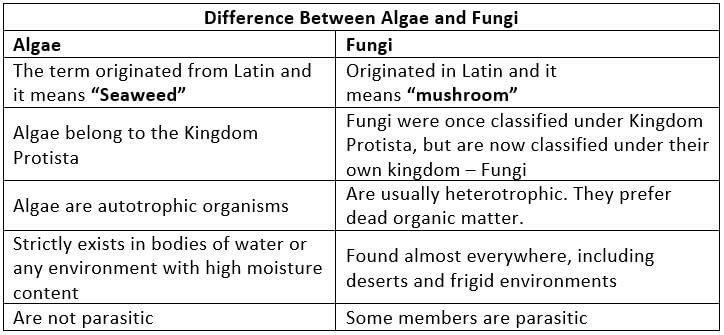
Similarities between Algae and Fungi
Following are the important similarities between algae and fungi:
- Both algae and fungi are thallophytes.
- Vascular tissue is absent in both groups.
- Algae and fungi are eukaryotes (exception blue-green algae).
- Both are placed together in the division thallophyta of cryptogams.
- Both can reproduce by fragmentation.
- Both can reproduce asexually.
- Their reproductive organs do not have a protective covering.
Lichens
A lichen is not a single organism but a symbiosis among different organisms like fungus and a cyanobacterium or algae. Cyanobacteria are also referred to as blue-green algae despite the fact of being distinct from algae. The non-fungal part is known as photobiont that contains chlorophyll. Many lichen partners include one photobiont and one mycobiont which is not universal and there are lichens with more than one photobiont partner. The fungal partner is viewed to be composed of filamentous cells and every filament is known as hypha. These hyphae may branch but maintain a constant distance and grow by extension. There is few lichens with filamentous structure among the photobionts while others consist of chains of more or fewer cells.
The species of Ascomycetes or Basidiomycetes are the most common fungi in lichens. The common algal partners are either the green algae Chlorophyta or Cyanophyceae family of blue-green bacteria. Normally, fungal partners cannot live without their phycobiont, but algae are often capable of living independently in water or moist soil. The largest lichen can make a thallus up to 3ft long, although most of them are smaller than a few centimeters. They are colorful, ranging from yellow to greens and black hues.
Mostly, lichens grow slowly. The one in which the phycobiont is a blue-green bacterium has the ability to convert nitrogen gas into ammonia. Some can reach the age of many centuries, mainly the one living in stressful environments such as arctic tundra or alpine.
Types of lichens
Lichens exist in one of the below-mentioned growth forms.
- Crustose grows across the substrate.
- Foliose are flat, leaf-like sheets of tissues and not bound closely.
- Squamulose are closely clustered and lit flattened pebble units.
- Fruticose are freely available standing branching tubes.
As per the diversity of basic growth, lichens have an identical internal morphology. The filaments of the fungal partner form the bulk of the lichen’s body, and the layers in the lichen are defined by the relative density of these filaments.
The filaments are packed closely at the outer surface to form a cortex that helps in contact with their surroundings.
The algal partner cells are not distributed below the cortex as the fungal filaments are scattered. The medulla is below the algal layer which is a loosely woven layer of fungal filaments. There is another layer beneath the medulla in foliose lichens and is in direct contact with the underlying substrate in squamulose and crustose lichens.
Root
 Roots are the descending part of the plant and serve the purpose of anchorage of plants, absorption of water and mineral nutrients, and storage of food. The primary root (develops from the radicles of the embryo) and its branches constitute the taproot system. Adventitious roots are those coming out from any abnormal position. It may be fibrous when coming out of the base of the stem, nodes, or internodes as in onion, sugarcane, bamboos, etc. and foliar when come out of the leaf, as in Bryophyllum. Adventitious roots many come out of other places too.
Roots are the descending part of the plant and serve the purpose of anchorage of plants, absorption of water and mineral nutrients, and storage of food. The primary root (develops from the radicles of the embryo) and its branches constitute the taproot system. Adventitious roots are those coming out from any abnormal position. It may be fibrous when coming out of the base of the stem, nodes, or internodes as in onion, sugarcane, bamboos, etc. and foliar when come out of the leaf, as in Bryophyllum. Adventitious roots many come out of other places too.
Modification of roots
Some other modifications of Roots are
- In banyan, the aerial branches produce the prop roots to provide mechanical support to the foliage. In maize and sugarcane, the stilt roots from the nodes just above the ground provide additional support to the stems. In Ivy and betel, the roots serve as organs of climbing and clinging to their natural habitats.
- In Rhizophora and Sonneratia, the roots come out of the soil to help in aeration and respiration. In banyan and orchids, the aerial roots are modified to absorb moisture from the atmosphere. In parasites such a Cuscuta and Orobanche, the roots absorb food from their respective hosts.
- In legumes, the roots containing Rhizobium help in the fixation of atmospheric nitrogen. In Asparagus and sweet potato, the roots are employed for vegetative propagation. In Tinospora, roots act as additional assimilatory organs and in Jussiaea, as floating organs. In some aquatic plants, for Example Utricularia, Ceratophyllum and Myriophyllum roots may be lacking.
Stem
Stem arises from the plumule of the embryo the ascending part of the plant, bears nodes, internodes, leaves, buds, and flowers.
Modifications of stem can be of the following types
➤ Underground
- Perennation
- Storage of food
- Propagation and which can be:
(i) Rhizome: Example: Ginger,
(ii) Tuber: Example: Potato,
(iii) Bulb: Example: Onion,
(iv) Corm: Example: Amorphophallus.
➤ Sub-aerial: With the purpose of propagation and which can be:
- Runner: Example: Oxalis
- Stolon: Example: Colocasia
- Offset: Example: Pistia
- Sucket: Example: Chrysanthemum
➤ Aerial: With some specialized purpose:
- Tendril: for climbing, Example: Passionflower
- Thorns: for Protection, Example: Lemon
- Phylloclade: for Photosynthesis, Example: Cactus
- Cladode: for Photosynthesis, Example: Asparagus
Plant Groups
➤ Crypto games (Seedless Plants)- Thallophyta: The plant body is made of the thallus. There is no root, stem, or leaf. Vascular tissue is absent There is no embryo formation. These plants usually inhabit the water.
Example: Algae and Fungi - Bryophyta: The plant body is made of the thallus. Some primitive types of root, stem, and leaf are present, but in the true sense, they are not the root, stem, or leaves. Vascular tissue is absent, but if present they are false. Embryo formation takes place.
Water is needed for their reproduction and also inhabits swampy places; hence, termed amphibious plants. - Pteridophyta: The plant body is divided into true root, stem, and leaves. Vascular tissues are present. Embryo formation takes place. In a true sense, they are land inhabiting plants.
➤ Phanerogams (Seed Bearing Plants)
- Gymnosperms: They are naked seeded plants, i.e., seeds are not found in the fruit. Vascular tissues are present, but the xylem lacks vessel a contrast feature to the Angiosperms. Characteristically, they are an intermediate group between pteridophytes and Angiosperms.
They are also called the fossil group since the group includes all the plants of fossil importance. Cycas revoluta, the plant is cultivated in gardens as an ornamental plant, is called “a living fossil” on account of its primitive character. The tallest tree sequoia gigantea belongs to this group. - Angiosperms: Their seed is found in fruits. Vascular tissues are complexed and more elaborate, and xylem has vessels. Angiosperms are the highly developed and most successful plants of today. Eucalyptus is the tallest angiosperms.
|
146 videos|358 docs|249 tests
|
FAQs on Bacteria, Virus, Algae, Fungi & Lichens - Science & Technology for UPSC CSE
| 1. What are bacteria? |  |
| 2. What is the difference between bacteria and viruses? |  |
| 3. Are all bacteria harmful? |  |
| 4. Can bacteria and viruses be classified as algae or fungi? |  |
| 5. What are lichens? |  |
|
146 videos|358 docs|249 tests
|

|
Explore Courses for UPSC exam
|

|
